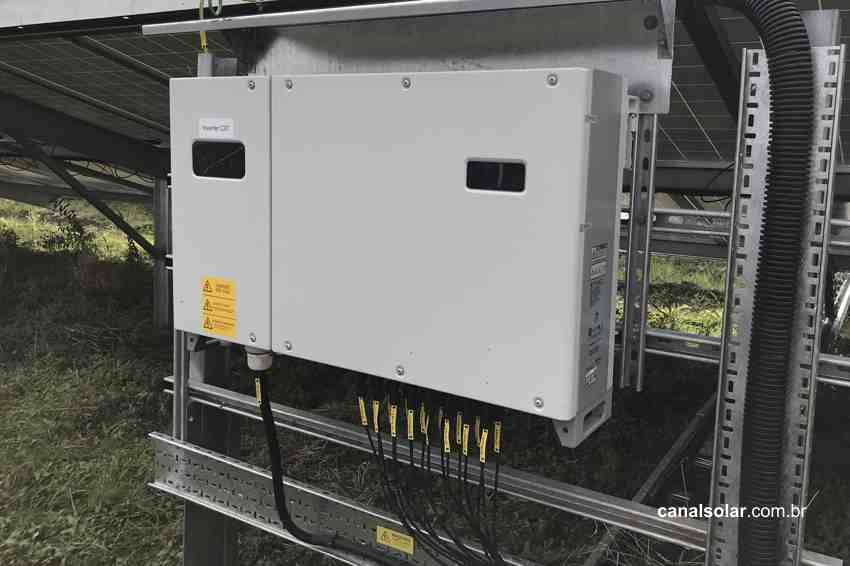Inverters have functions that are desirable and necessary to operate with photovoltaic systems, while other functions and some requirements are required by standard.
When we talk about technical requirements for inverters, the first reference we should consult is the standard NBR 16149: Photovoltaic (PV) Systems – Connection interface characteristics with the electrical distribution network.
This standard, as its name suggests, determines how photovoltaic inverters must behave when interacting with the low voltage electrical grid.
Tip: find the original standards at an affordable cost on the website target.com.br
In Brazil, in order to connect to the electricity grid, photovoltaic inverters up to 10 kW must comply, in addition to NBR 16149, with standards NBR 16150 and NBR 62116.
We will talk about standards in the next articles in the series, while we will focus in this article on some basic functions and characteristics of inverters.
Basic functions of inverters
Output current control
Photovoltaic inverters for grid connection (grid-tie) are electronic current sources. This means that these inverters do not supply electrical voltage at their terminals, like conventional DC-AC inverters. A grid-tie inverter is not capable of supplying any type of load on its own, and must always be connected to the electrical grid in order to operate.
What does it mean to be connected to the electrical grid? It means that the inverter receives the mains voltage at its terminals (127 V, 220 V, etc.) and uses this voltage as a reference for its operation.
Once connected to the grid, the inverter has the primary function of producing a sinusoidal electrical current at its output terminals, synchronized with the grid voltage waveform, with the aim of injecting energy extracted from the solar panels into the grid.
This energy can be consumed instantly by nearby loads or can be exported to the energy distribution company, if consumption at the injection point is lower than generation.

Input voltage control
The grid-tie inverter has an unusual feature, not found in other types of inverters: its input voltage is controlled. This is necessary to allow operation with voltage values that can be adjusted according to the type and number of photovoltaic modules connected to the inverter input.
Furthermore, this function is important because photovoltaic modules have variable output voltage. The modules, without the aid of an inverter, are unable to stabilize their output voltage. Photovoltaic modules in isolation are not useful for powering any type of load, requiring some external device (such as a grid-tie inverter) to control their output voltage.
The ability to have its input voltage adjusted, consequently adjusting the output voltage of the solar panels, is also necessary for the inverter's MPPT feature to work, which we will talk about next.

MPPT – Maximum Power Point Tracking
This is a very important feature, present in absolutely all photovoltaic grid-tie inverters. In order to extract the maximum amount of energy from a photovoltaic system, the panels must always operate at their maximum power point.
To achieve this, the inverters employ MPPT algorithms (Maximum Power Point Tracking – tracking of maximum power point). The MPPT system works in conjunction with the inverter input voltage control system. The objective of the algorithm is to establish the ideal operating voltage value of the photovoltaic modules.
This information is sent to the voltage control system, which sets the solar panels to operate exactly (or as close as possible) to their maximum power point. The MPPT feature is useful (and necessary) so that the inverter can adapt to any type or quantity of photovoltaic modules (respecting the inverter's operational limits).
The MPPT and the voltage control system work together to make this adjustment possible. During an operating day, the maximum power point of photovoltaic modules varies according to irradiance (intensity of sunlight), temperature and the presence of shadows.
The inverter is then forced to adapt, constantly adjusting the operating voltage of the photovoltaic modules to seek their maximum power point.

Leakage current monitoring
In photovoltaic installations, as in any electrical installation, there may be undesirable leakage currents in equipment and components. Leakage currents are electrical currents that deviate from their original path and flow into the earth or pass through the body of a person or animal (when an electric shock occurs).
Leakage currents must be avoided as a protective measure, as their presence indicates the existence of faults or defects.

Desirable functions and characteristics in inverters
MPPT with global maximum power point search
The quality of an inverter's MPPT system says a lot about it. Normally in manufacturers' catalogs the efficiency of the equipment is specified, but the efficiency of the MPPT algorithm is never mentioned, that is, the inverter's ability to always seek the best operating point for the modules.
A bad MPPT system, even in a good quality inverter, can reduce the performance of the photovoltaic system, especially in non-ideal operating situations, with the presence of shadows and dirt. The ability to search for global maximum power points (and not just local ones, as is the standard in most equipment) is very desirable in inverters.

Multiple MPPT inputs
Inverters traditionally had only one MPPT input. This means that all strings of modules connected to the inverter, regardless of quantity, were treated as a single set.
The inverter with only one MPPT input tracks the maximum power point of the entire set of parallel strings, not being able to optimize the operation of the photovoltaic system when there are modules or strings operating in unequal situations (different inclinations and shadow conditions). , for example).
On the other hand, the MPPT multi-input inverter has the ability to look individually at strings or small groups of strings of PV modules, making the operation of the PV system more efficient.
The presence of some operational change in the strings of an input (such as a shadow) does not affect the strings that are linked to the other inputs. In equipment with multiple MPPT inputs, it is also possible to have strings with different characteristics (types and quantities of photovoltaic modules) connected to different inputs, as the inputs are absolutely independent.

High conversion efficiency
This is a desired requirement in any type of equipment or machine and is not exclusive to photovoltaic inverters. Typically photovoltaic inverters have efficiencies of 96% to 98%. Efficiency measures how much energy is consumed within the equipment and is defined as the ratio between the output power and the input power of the inverter.
The efficiency of an inverter must always be as high as possible, as any small variation of just 1% can have a large impact on results over time. An energy loss of just 1% in a solar plant can represent a large amount of energy over the years. That is why the efficiency of the inverter is one of the first items that must be evaluated when choosing the equipment.

Low harmonic current content
A good current control system, combined with a good output filter, is necessary to enable the generation of currents with low distortion, without the presence of many harmonics. The NBR 16149 standard limits the harmonic content of the output current of grid-tie inverters in Brazil to 5%.
The lower the harmonic content, the lower the impact caused by the inverter to the electrical grid. The level of harmonic distortion of the inverter's output current must be low as large harmonic currents cause damage to the electrical network, mainly: increased losses, electromagnetic interference and resonances.

Wide input voltage range
Photovoltaic inverters have a minimum and maximum operating voltage limit. An inverter with wider limits, with a wider range of input voltage, allows greater flexibility in the composition of photovoltaic projects, allowing the same equipment to be used in projects with different types and quantities of modules in series.
Normally in inverters for microgeneration, with powers of up to a few kilowatts, the input voltages are more flexible, with a wider range. In inverters for power plants, this characteristic is already more restricted, with a narrow input voltage range and little choice in the number of string modules.
















2 Responses
Congratulations Marcelo for the article, clear and objective explanation. Could you explain how the photovoltaic inverter manages to inject energy into the load, to the detriment of the grid energy, or better yet, why the load is preferentially fed by the photovoltaic system, instead of the grid energy, if they are in parallel, the two systems should act together .
Hello, Paulo, how are you? We appreciate the recognition! Contact our consultants and learn about the Fundamentals of Solar Energy course, which will help you with any questions: http://whts.co/CanalSolar-cursos. And read the article: https://canalsolar.com.br/funcoes-e-requisitos-tecnicos-dos-inversores-fotovoltaicos/